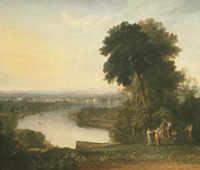|

Thomson's
Aeolian Harp by Joseph Mallord William.
Manchester Art Gallery
|
Office workers who would normally step into a pub or gym to cope
with the stress of a working day are being invited instead to
sit in front of a painting.
Manchester Art Gallery has recruited two of the country's leading
experts in stress management to choose pictures that are guaranteed
to leave even the most frantic feeling
at ease with the world.
They have created the "tranquility
tour" which allows city-centre workers to spend their lunch
hour taking a soothing tour of what are described as "some
of the most relaxing and inspiring paintings ever committed to
canvas". The free tour takes the visitor through several
centuries of painting, from the Victorian aesthetic movement,
through the Pre-Raphaelite school, to modern abstract art.
Kim Gowland, a gallery executive, said: "Looking at art
is a stress-relieving activity. What we are trying to do is encourage
people who work in the city to spend half an hour of their lunchbreak
in the gallery, to chill out rather
than rush around the shops."
The five works chosen by Andrew Loukes, the gallery's curator,
are: John Roddam Spencer Stanhope's The
Waters of Lethe (1880), Turner's Thomson's
Aeolian Harp (1809), Sir John Everett Millais's Autumn
Leaves (1856), James Durden's Summer
in Cumberland (1925) and Bridget Riley's Zephyr (1976).
Mr Loukes said: "We chose five pictures that suggest restfulness.
We also wanted to display the breadth of the collection. We are
particularly strong in early-19th and early- 20th-century British
art."
Their therapeutic powers have been endorsed by Olga Gregson and
Terry Looker from the Department of Biological Sciences at Manchester
Metropolitan University.
Dr Gregson said that "research shows that stress levels
have reduced and moods changed for the better" when subjects
looked at paintings.
"Although art appreciation is very much a matter of personal
choice, it is true that some works of art appeal to almost everyone,
and that some paintings have qualities that can induce relaxation
in most people," Dr Gregson said. "Great painters such
as Leonardo da Vinci were masters of techniques that could evoke
particular responses in the viewer."
Dr Gregson said the gallery represented an "oasis of calm".
"You have got this wonderful opportunity to evoke a different
kind of psychophysiological response."
(Agencies)
